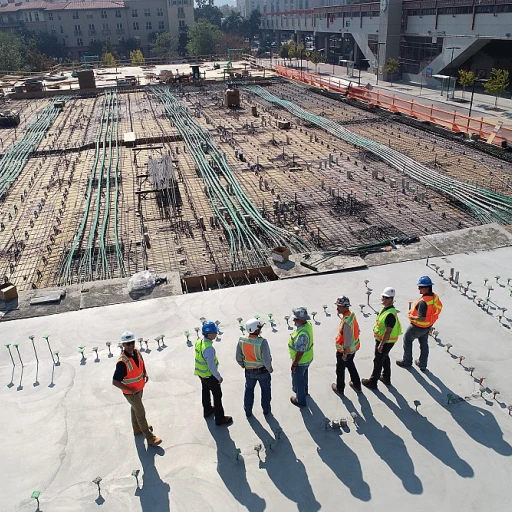
Understanding the Role of 360-Degree Evaluations in Employee Retention
The Importance of 360-Degree Evaluations in Retaining Talent
Understanding the intricate dynamics of employee retention is crucial for maintaining a productive and engaged workforce. 360-degree evaluations play a pivotal role in this process by facilitating comprehensive performance reviews. These assessments gather feedback from various perspectives, including team members, supervisors, and the individuals themselves. This wide-ranging feedback process provides invaluable insights into an employee's performance, skills, and development needs. 360-degree evaluations are not just about assessing past performance—they are about paving the way for future growth. By engaging in this holistic review process, organizations can tailor development plans that cater to the unique needs of each employee, thus promoting professional growth. A well-executed feedback survey can effectively identify areas where an individual's abilities could be enhanced, which aligns perfectly with their goals and the overarching objectives of the team. Providing open-ended questions in the evaluation allows team members to express their views candidly, encouraging honest and constructive feedback. The ability to gather both quantitative data through scales and qualitative insights through open-ended questions ensures that the feedback is balanced and comprehensive. For organizations looking to increase employee engagement and retention, incorporating 360-degree evaluations into the performance management strategy is essential. This process not only nurtures an employee's development but also contributes to a positive workplace culture. As team members feel their input is valued, their attachment to the organization strengthens, reducing turnover rates and enhancing the overall workplace environment. The use of 360-degree feedback is a powerful tool in the arsenal of performance management strategies, particularly when it effectively measures employee engagement and satisfaction. Ensuring a well-rounded approach to performance reviews can help prevent issues before they escalate, offering timely interventions that can make a significant difference in retention rates. Learn more about creative ways to show appreciation to employees as part of fostering a supportive and retaining workplace culture.Key Elements of Effective 360-Degree Evaluation Questions
Critical Components of Successful Evaluation Questions
Creating effective 360-degree feedback questions is vital for garnering valuable insights into employee performance and development. Here’s a breakdown of key elements to include:- Open-ended Questions: These encourage team members to provide thoughtful and individualized responses. Open-ended questions can delve deeper into an employee's skills, challenges, and growth opportunities, yielding insights beyond standard performance reviews.
- Balanced Between Quantitative and Qualitative: A mix of both scale-based queries and open feedback provides a comprehensive view of employee performance. While quantitative questions offer measurable data, qualitative feedback is crucial for understanding the context of an individual's role within the team.
- Tailored to the Individual: Feedback questions should be relevant to the specific responsibilities and goals of the person being evaluated. This personalization aids in aligning the assessment with the employee’s job function and development objectives.
- Focus on Development and Problem Solving: Questions should target areas like problem-solving ability, professional growth, and performance management. This ensures that feedback is not only about past performance but also paves the way for future improvement.
Crafting Questions to Address Employee Development and Growth
Crafting Questions That Promote Growth and Development
In the landscape of employee retention, crafting effective questions for 360-degree feedback can significantly drive development and career growth. When using feedback from these evaluations, it is crucial to focus on open-ended questions that encourage introspection and personal analysis. Developing questions that prompt employees to consider their skills, goals, and abilities in various scenarios can be a game-changer in performance management. For instance, open-ended questions like, "In what areas do you believe you have the most potential for growth?" or "How can management support your professional aspirations?" provide individuals the freedom to express their development interests. This approach not only underscores the significance of individual contributions but also aligns with organizational objectives. Incorporating a balance of quantitative and qualitative feedback questions ensures a comprehensive evaluation of employee performance. While a rating scale might offer a quick review, open-ended feedback often yields insights into problem-solving capabilities and teamwork effectiveness of team members. Questions such as "Describe a recent challenge and how you managed to overcome it" can offer a window into an employee's problem-solving approach and resilience. Moreover, recognize the value of degree feedback from a diverse circle of colleagues, supervisors, and subordinate peers. This not only enhances the credibility of feedback but also brings in varied perspectives on an employee's performance and potential development areas. Management should foster an environment where employees feel comfortable offering constructive feedback. Encouraging honest discussion through well-thought-out feedback questions will more effectively engage employees in their performance reviews, thereby driving a well-rounded development process.Encouraging Honest and Constructive Feedback
Promoting Transparency and Candor in the Feedback Process
Fostering honest and constructive feedback within the framework of 360-degree evaluations is pivotal for enhancing employee performance and retention. To achieve this, it's essential to cultivate an environment where team members feel comfortable expressing their perspectives openly and without fear of negative repercussions. Honest feedback is more likely to occur when employees understand that their input is valued and contributes to the organization's growth as well as their own professional development. By clearly communicating the purpose and benefits of feedback surveys and performance reviews, management can encourage participation from all levels of the team.Designing Feedback Channels That Encourage Open Dialogue
Structuring effective feedback channels involves incorporating open-ended questions that allow employees to communicate freely. These questions should prompt employees to articulate specific examples related to the employee performance they are evaluating, ensuring feedback remains constructive and actionable. Here are several strategies to encourage meaningful feedback dialogue:- Use Specific and Open-Ended Questions: When crafting your feedback questions, aim for clarity and specificity. Questions such as, "Can you describe a time when this individual demonstrated problem solving skills?" or "In what ways do you think the person could enhance their team collaboration?" solicit detailed responses.
- Provide Anonymity Where Necessary: Ensuring the feedback process respects individual confidentiality can lead to more candid feedback. Anonymity enables individuals to share insights without the fear of judgment or conflict.
- Create a Balanced Rating Scale: Incorporate a scale in your degree evaluations that allows respondents to rate aspects of performance while still providing them space to elaborate with additional comments.
Training Evaluators to Give Constructive Criticism
Effective degree feedback hinges on the ability of evaluators to provide constructive criticism. Training sessions focusing on how to communicate feedback respectfully and professionally are crucial. These should emphasize the need to balance compliments with areas of improvement, focusing on behavior and skills rather than personal attributes. By ensuring all team members are equipped to give feedback that is both positive and corrective, you align the feedback process with overall organizational goals and improve the engagement of well employees. In conclusion, the true potential of a 360-degree evaluation lies in its ability to induce transparent, open-ended conversations that lead to meaningful employee development. This, in turn, can drive performance and enhance retention.Using Feedback to Foster a Positive Workplace Culture
Promoting Transparence and Positivity through Feedback
Creating a workplace culture that thrives on open communication and honest feedback starts with encouraging transparency in the feedback process. A key component in fostering a positive environment is the ability to provide feedback that is both constructive and actionable. Degree feedback plays a significant role in this process, allowing team members to voice their perspectives on an individual's performance. Through feedback questions that are open-ended, tailored to assess skills and problem-solving abilities, employees are better positioned to engage with their roles and work toward personal and professional growth. Including performance reviews that emphasize not only the current performance but also future goals is crucial in developing strategies for employee engagement. Feedback survey techniques, especially those integrating open-ended questions, provide insights into how well employees are interacting with their team and their alignment with organizational objectives. Such degree performance feedback equips management with a clearer understanding of the overall team dynamics, highlighting areas where performance management can be enhanced effectively. Review questions should be designed to solicit constructive feedback while remaining respectful and supportive of the individual's personal development journey. Incorporating these strategies into your organization’s feedback loop can significantly impact employee performance, management practices, and team cohesion. By valuing the input each person provides, and utilizing it to drive positive change, one can inspire the cycle of continuous improvement and retention.Measuring the Impact of 360-Degree Evaluations on Retention Rates
Evaluating the Effectiveness of 360-Degree Feedback on Retention
Measuring the impact of 360-degree evaluations on employee retention is crucial to understanding their effectiveness. When implemented correctly, these evaluations can significantly enhance employee engagement and retention rates. Here's how you can assess their impact:
- Track Retention Rates: Begin by monitoring retention rates before and after implementing 360-degree feedback. Look for patterns or changes in employee turnover to gauge the evaluation's influence.
- Analyze Feedback Quality: Evaluate the quality of feedback provided. Are the questions eliciting constructive feedback that aids in employee development and growth? High-quality, open-ended questions can lead to meaningful insights into employee performance and satisfaction.
- Employee Performance Improvement: Assess whether there's an improvement in individual and team performance. Effective feedback should lead to enhanced skills and problem-solving abilities, contributing to overall performance management.
- Employee Engagement Surveys: Conduct surveys to measure employee engagement levels. Increased engagement often correlates with positive feedback processes and well-structured performance reviews.
- Feedback Utilization: Determine how well the feedback is being utilized by management and employees. Are the insights from the feedback being translated into actionable goals and development plans?
- Review Feedback Process: Regularly review the feedback process itself. Ensure it remains relevant and aligned with organizational goals and employee needs.
By focusing on these areas, organizations can effectively measure the impact of 360-degree evaluations on retention rates, ensuring that the feedback process not only supports employee development but also fosters a positive workplace culture.












